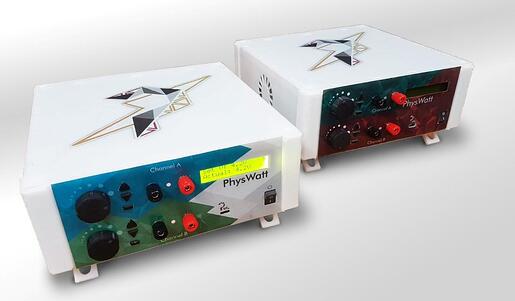A standalone programmable CP, CC/CV power supply.
PhysWatt is a programmable CP, CC/CV power supply that has been developed by the PhysLab team. A standalone as well as a PhysLogger-compatible instrument, it is extremely easy to use and can be integrated in an array of experiments and applications.
Versatile Beyond Imagination
An all-rounder programmable power supply, PhysWatt can operate as both, a constant power (CP) and a constant current or voltage (CC/CV) supply—automatically switching between the CC and CV modes. Use it as a standalone instrument or interface with PhysLogger, utilize its multiple modes to easily generate, adjust, record, and manipulate any AC or DC waveform of your choice. More than just a bench power supply, PhysWatt combines the capabilities of numerous instruments such as a signal generator, oscilloscope, and temperature controller!
Simple in Usage; Powerful in Performance
PhysWatt has four output channels: two adjustable front channels and two fixed 12 V rear channels. The adjustable channels offer both BNC and banana connectivity and the fixed channels are connected via a screw terminal connector. A LED digital readout at the front panel means you do not need to connect additional meters to measure the current or voltage.
When using standalone, control all modes and parameters simply with knobs and buttons and when integrated with PhysLogger, use intuitive dragging and dropping and widgets in the software to achieve extended control and functions!
| Mode | Range |
|---|---|
| Independent | Each adjustable front channel operates independently on a maximum power curve of 35 W, offering a combination of maximum voltages and currents, (Vmax = 10 V, Imax = 7.95 A). Channel A: V = 0–10 V Channel B: V = 0–10 V |
| Bipolar | Connect both channels to power bipolar circuits and achieve three terminals. Channel A: V = 0–10 V, Channel B: V = -10–0 V |
| Alternating Current | Combining both channels of PhysWatt, this mode allows the generating of voltage signals with changing polarity and an amplitude as high as 10 V. Channel A or B: V = ± 10 V |
| Double Range | Combining the potential of both channels, this range allows a direct current as high as 20 V to be supplied from one channel (the other channel is disabled). Channel A or B: V = 0–20 V |
